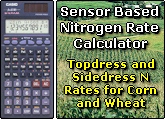 Introduction, Sensor Based N Rate
Calculator (SBNRC)
Introduction, Sensor Based N Rate
Calculator (SBNRC)

Sensor Based
Nitrogen Rate Calculator, on-line since 2002
What Can the SBNRC do for you?
Using this system, you can enter GreenSeeker sensor data into the
calculator
tailored for many different crops and regions, and get reliable mid-season
fertilizer N rates that will optimize farmer profits. Over many
years of research, farmer profits can be increased by more than $10/ac
(wheat) and $20/ac (corn) using this system, and that delivers improved
nitrogen use efficiency over conventional practices.
How the SBNRC works?
This approach relies on placing preplant Nitrogen Rich Strips in
farmer fields, whereby mid-season NDVI sensor readings are collected and a
response index determined that indicates the likelihood of obtaining a
response to topdress N. Combined with crop and region specific models that
predict yield, N fertilizer rates are determined by projecting removal as
a function of yield, known concentrations of N in different cereal grains
and the respective N removal amounts (N fertilized and non-fertilized),
and the predicted responsiveness to applied N at each site using the
response index.
Using the Sensor Based N Rate Calculator, topdress N rate recommendations can be determined from Feekes 4 to Feekes 6 (see chart below), and between V8 and V12 in corn (Iowa State University, How the Corn Plant Develops).
How does Planting Date and Sensing Date Affect N Rate Recommendations?
In wheat and corn, the earlier N is applied the better the chances that maximum yields can be achieved. However, with both, the earlier that sensor readings are taken, yield prediction is less accurate. Thus, N rate recommendations are more precise when determined later (Feekes 6 in wheat, and V12 in corn), but the later N is applied, the likelihood of achieving maximum yield (if a deficiency exists) is reduced.
The Sensor Based Nitrogen Rate Calculator (SBNRC) is the only free on-line sensor-based N recommendation calculator in the world. This web-based application allows farmers, large and small, developed, and developing to obtain reliable in-season N fertilizer recommendations for corn, spring wheat, winter wheat, sorghum, and bermudagrass without having to take a soil test. All that is required is that farmers place a Nitrogen Rich Strip within each production field, prior to planting.

The yield potential prediction equation
listed above included winter wheat planted from September 24 to December
1, and sensed between February 5, and April 2. This includes a range
of 55 to 127 days where GDD>0. Accurate mid-season N rates can be
determined between Feekes 4 and Feekes 6.

According to Large (1954) cereals develop as
follow Feekes Growth Stages
Stage
T I L L E R I N G
1 One shoot (number of leaves can be added) = "brairding"
2 Beginning of tillering
3 Tillers formed, leaves often twisted spirally. In some
varieties of winter wheats,
plants may be "creeping" or prostrate
4 Beginning of the erection of the pseudo-stem, leaf sheaths
beginning to lengthen
5 Pseudo-stem (formed by sheaths of leaves) strongly erected
S T E M E X T E N S I O N
6 First node of stem visible at base of shoot
7 Second node of stem formed, next-to-last leaf just visible
8 Last leaf visible, but still rolled up, ear beginning to
swell
9 Ligule of last leaf just visible
10 Sheath of last leaf completely grown out, ear swollen but
not yet visible
H E A D I N G
10.1 First ears just visible (awns just showing in barley, ear
escaping through split of sheath
in wheat or oats)
10.2 Quarter of heading process completed
10.3 Half of heading process completed
10.4 Three-quarters of heading process completed
10.5 All ears out of sheath
F L O W E R I N G (WHEAT)
10.5.1 Beginning of flowering (wheat)
10.5.2 Flowering complete to top of ear
10.5.3 Flowering over at base of ear
10.5.4 Flowering over, kernel watery ripe
R I P E N I N G
11.1 Milky ripe
11.2 Mealy ripe, contents of kernel soft but dry
11.3 Kernel hard (difficult to divide by thumb-nail)
11.4 Ripe for cutting. Straw dead
Reference
Large, E.C. 1954. Growth stages in cereals. Plant Pathol. 3:128-129.
_files/nitrogen_rich.jpg)
The earlier the better for
mid-season determination of topdress N rates
Article Delineating the
Actual Algorithm EMPLOYED in the SBNRC
Outline for Generating New Crop Algorithms
for N Fertilization